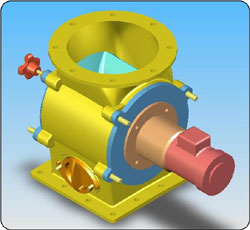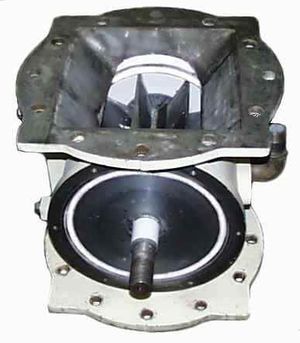Difference between revisions of "Airlocks"
| Line 1: | Line 1: | ||
[[Category:Valves]]{{Knoppen}} | [[Category:Valves]]{{Knoppen}} | ||
[[File:Rotary valve1.jpg|thumb|right|Rotary Valves]] | |||
[[File:Rotary valves.jpg|thumb|right|Rotary Valves]] | |||
An '''Airlock''' is a type of valve in which the rotation of a passage or passages in a transverse plug regulates the flow of liquid or gas through the attached pipes. The common stopcock is the simplest form of rotary valve. | |||
[[File: | |||
[[File: | |||
'''Airlock''' is a | |||
==Applications== | ==Applications== | ||
* | Rotary valves have been applied in numerous applications, including: | ||
* | * Changing the pitch of brass instruments. | ||
* | * Controlling the steam and exhaust ports of steam engines, most notably in the Corliss steam engine. | ||
* | * Periodically reversing the flow of air and fuel across the open hearth furnace. | ||
* | * Loading sample on chromatography columns. | ||
* | * Certain types of two-stroke engines. | ||
* Most hydraulic automotive power steering control valves. | |||
== | ==Use in brass instruments== | ||
In the context of brass instruments, rotary valves are found on horns, trumpets, trombones, flugelhorns, and tubas. Many European trumpet players tend to favor rotary valves. | |||
Trombone F-attachment valves are usually rotary, with several variations on the basic design also in use, such as the Thayer axial-flow valve and Hagmann valve. | |||
Joseph Riedlin is credited with the first use of rotary valves on brass instruments in 1832. | |||
==Use in industry== | |||
In industry, a rotary valve which can also be called [[Airlocks]] are often used to enter or extract material from two chambers with different pressure level.As part of the material exchange process, the valve is often used as a measuring or metering device. | |||
==Use in engine design== | |||
The rotary valve combustion engine possesses several significant advantages over the conventional assemblies, including significantly higher compression ratios and rpm, meaning more power, a much more compact and light-weight cylinder head, and reduced complexity, meaning higher reliability and lower cost. As inlet and exhaust are usually combined special attention should be given to valve cooling to avoid engine knocking. | |||
Rotary valves have been used in several different engine designs. In Britain, the National Engine Company Ltd advertised its rotary valve engine for use in early aircraft, at a time when poppet valves were prone to failure by sticking or burning.From the 1930s, Frank Aspin developed a design with a rotary valve that rotated on the same axis as the cylinder bore, but with limited success.Kawasaki and others have also used rotary valves in two-stroke motorcycle engines, where the arrangement helps to prevent reverse flow back into the intake port during the compression stroke. | |||
Austrian engine manufacturer Rotax used rotary intake valves in their now out-of-production 64 hp (48 kW) Rotax 532 two-stroke engine design and continues to use rotary intake valves in the 532's successor, the current-production 64 hp (48 kW) Rotax 582.US company Coates International Ltd has developed a spherical rotary valve for internal combustion engines which replaces the poppet valve system. This particular design is four-stroke, with the rotary valves operated by overhead shafts in lieu of overhead camshafts . The first sale of such an engine was part of a natural gas engine-generator.UK company RCV Engines Ltd uses rotating cylinder liner technology as a specialized form of rotary valve in their model engine and small-engine line-up.Rotary valves are highly suitable for high reving engines, such as those used in sportscars and F1 racing cars, on which traditional [[Poppet Valves]] with springs can fail due to spring resonance and where the desmodromic valve gear is too heavy, large in size and too complex to time and design properly. Rotary valves allow for a more compact and lightweight cylinder head design. They rotate at half engine speed and lack the inertia forces of reciprocating valve mechanisms. This allows for higher engines speeds offering appr. 10% more power. The 1980s MGN W12 F1 engine used rotary valves but never raced. Between 2002 and 2004 the Australian developer Bishop Innovation and Mercedes-Ilmor tested rotary valves for a F1 V10 engine. | |||
Bishop Innovations patent for the rotary valve engine was bought out by BRV Pty Ltd, owned by Tony Wallis, one of the valves original designers. BRV has constructed several functional motors using the rotary valve technology, such as a Honda CRF 450, which had greater torque at both low(17% increase) and high (9% increase) engine speeds, and also produced more brake horsepower up to around 30% more at functional engine speeds.The engine was also considerably smaller and lighter, as the cylinder head assembly was not as large. | |||
==Use in chromatography== | |||
Rotary valves are used for loading samples on columns used for liquid or gas chromatography. The valves used in these methods are usually 6-port, 2-position rotary valves. | |||
==Sources== | ==Sources== | ||
[http://en.wikipedia.org/wiki/ | [http://en.wikipedia.org/wiki/Rotary_valve Wikipedia Rotary valves] | ||
Latest revision as of 10:11, 4 April 2014
An Airlock is a type of valve in which the rotation of a passage or passages in a transverse plug regulates the flow of liquid or gas through the attached pipes. The common stopcock is the simplest form of rotary valve.
Applications
Rotary valves have been applied in numerous applications, including:
- Changing the pitch of brass instruments.
- Controlling the steam and exhaust ports of steam engines, most notably in the Corliss steam engine.
- Periodically reversing the flow of air and fuel across the open hearth furnace.
- Loading sample on chromatography columns.
- Certain types of two-stroke engines.
- Most hydraulic automotive power steering control valves.
Use in brass instruments
In the context of brass instruments, rotary valves are found on horns, trumpets, trombones, flugelhorns, and tubas. Many European trumpet players tend to favor rotary valves. Trombone F-attachment valves are usually rotary, with several variations on the basic design also in use, such as the Thayer axial-flow valve and Hagmann valve. Joseph Riedlin is credited with the first use of rotary valves on brass instruments in 1832.
Use in industry
In industry, a rotary valve which can also be called Airlocks are often used to enter or extract material from two chambers with different pressure level.As part of the material exchange process, the valve is often used as a measuring or metering device.
Use in engine design
The rotary valve combustion engine possesses several significant advantages over the conventional assemblies, including significantly higher compression ratios and rpm, meaning more power, a much more compact and light-weight cylinder head, and reduced complexity, meaning higher reliability and lower cost. As inlet and exhaust are usually combined special attention should be given to valve cooling to avoid engine knocking.
Rotary valves have been used in several different engine designs. In Britain, the National Engine Company Ltd advertised its rotary valve engine for use in early aircraft, at a time when poppet valves were prone to failure by sticking or burning.From the 1930s, Frank Aspin developed a design with a rotary valve that rotated on the same axis as the cylinder bore, but with limited success.Kawasaki and others have also used rotary valves in two-stroke motorcycle engines, where the arrangement helps to prevent reverse flow back into the intake port during the compression stroke.
Austrian engine manufacturer Rotax used rotary intake valves in their now out-of-production 64 hp (48 kW) Rotax 532 two-stroke engine design and continues to use rotary intake valves in the 532's successor, the current-production 64 hp (48 kW) Rotax 582.US company Coates International Ltd has developed a spherical rotary valve for internal combustion engines which replaces the poppet valve system. This particular design is four-stroke, with the rotary valves operated by overhead shafts in lieu of overhead camshafts . The first sale of such an engine was part of a natural gas engine-generator.UK company RCV Engines Ltd uses rotating cylinder liner technology as a specialized form of rotary valve in their model engine and small-engine line-up.Rotary valves are highly suitable for high reving engines, such as those used in sportscars and F1 racing cars, on which traditional Poppet Valves with springs can fail due to spring resonance and where the desmodromic valve gear is too heavy, large in size and too complex to time and design properly. Rotary valves allow for a more compact and lightweight cylinder head design. They rotate at half engine speed and lack the inertia forces of reciprocating valve mechanisms. This allows for higher engines speeds offering appr. 10% more power. The 1980s MGN W12 F1 engine used rotary valves but never raced. Between 2002 and 2004 the Australian developer Bishop Innovation and Mercedes-Ilmor tested rotary valves for a F1 V10 engine.
Bishop Innovations patent for the rotary valve engine was bought out by BRV Pty Ltd, owned by Tony Wallis, one of the valves original designers. BRV has constructed several functional motors using the rotary valve technology, such as a Honda CRF 450, which had greater torque at both low(17% increase) and high (9% increase) engine speeds, and also produced more brake horsepower up to around 30% more at functional engine speeds.The engine was also considerably smaller and lighter, as the cylinder head assembly was not as large.
Use in chromatography
Rotary valves are used for loading samples on columns used for liquid or gas chromatography. The valves used in these methods are usually 6-port, 2-position rotary valves.

